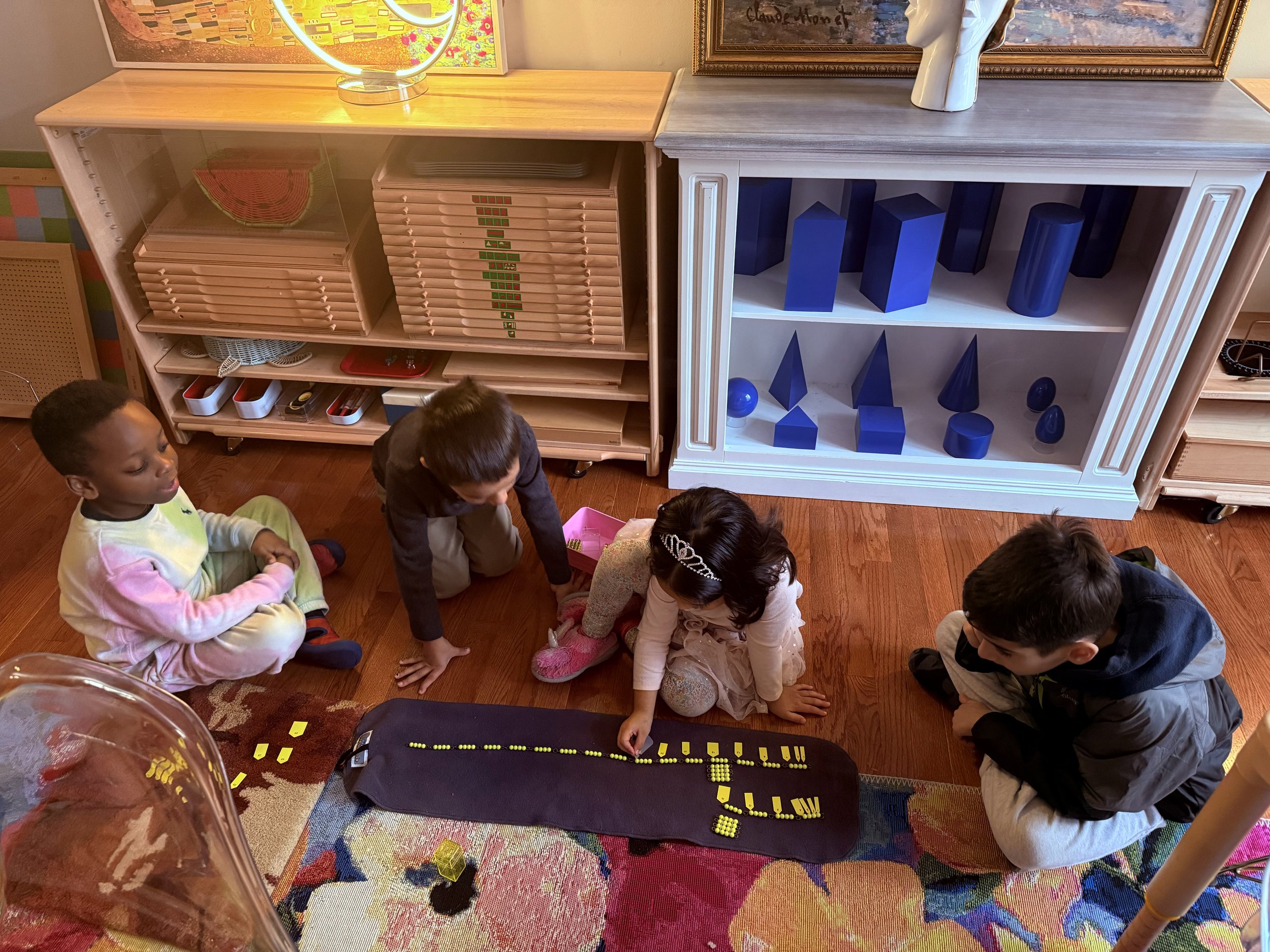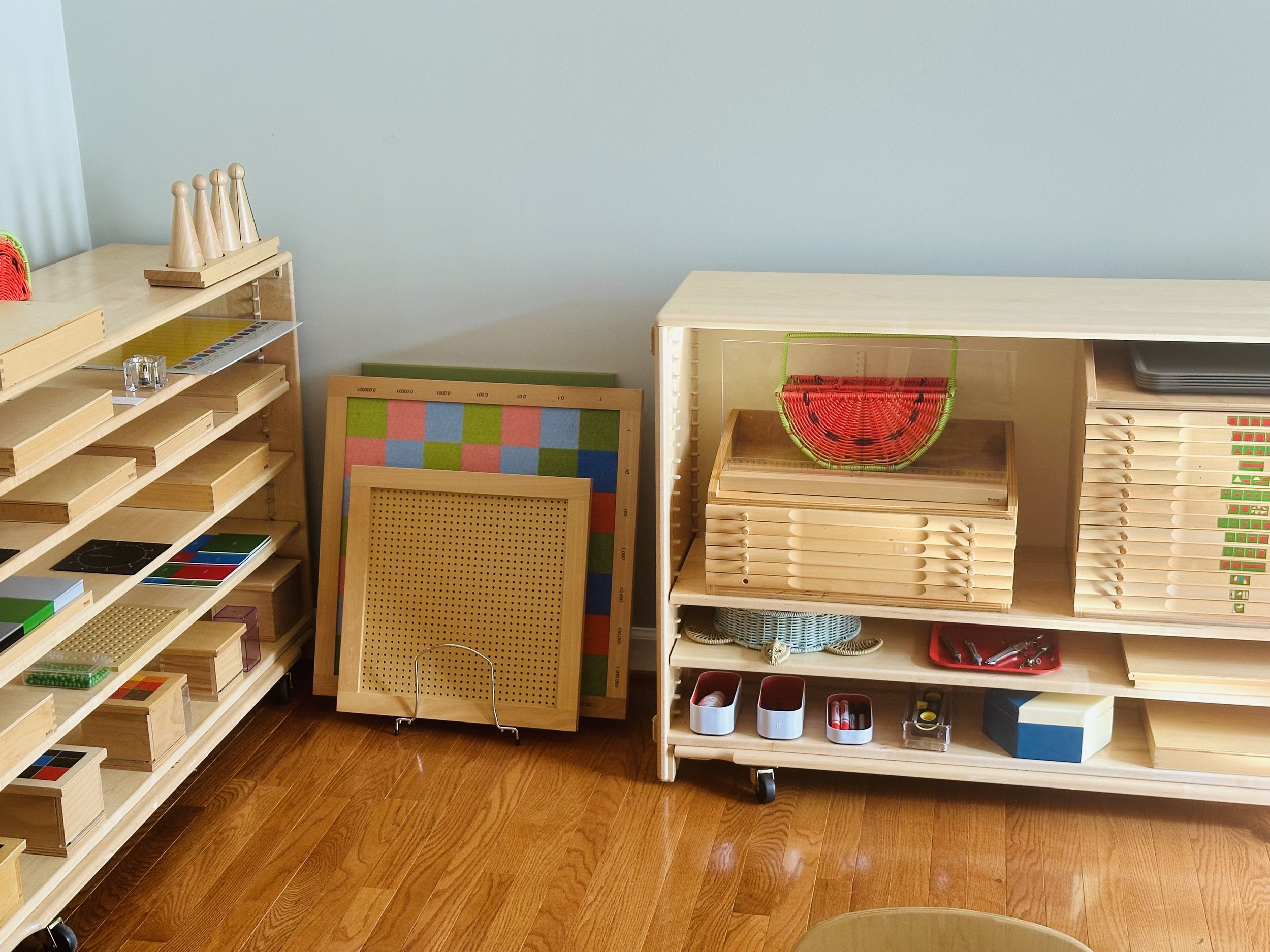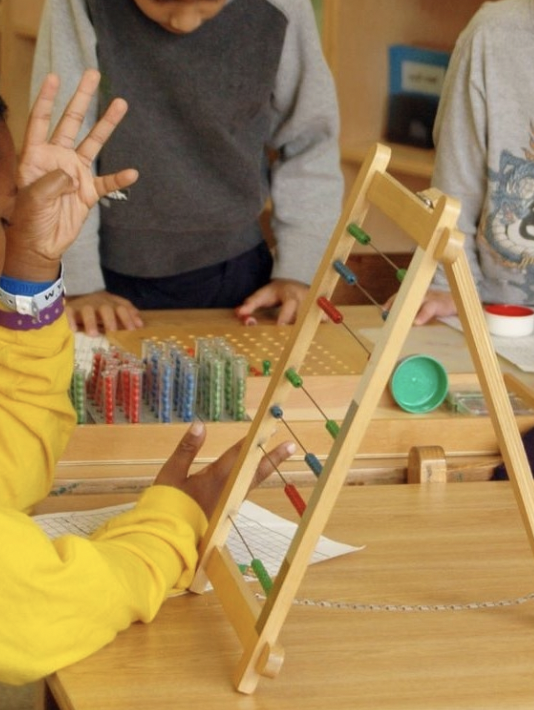ELEMENTARY
“The greatest gifts we can give our children are the roots of responsibility and the wings of independence.“
- Dr. Maria Montessori
The Elementary Montessori curriculum is extraordinarily comprehensive and perfectly suited to the needs of 6-12 year olds.(comparable to 1st – 6th grade). Children this age are intensely curious and very social. A “let’s go find out” atmosphere prevails. Children research answers to questions using classroom materials, the library media center and community resources. While Montessori Toddler and Primary classrooms are characterized by a ‘quiet hum’ as children work individually or in pairs, Elementary classrooms are notable for the sounds of exuberant students working together in groups.













JOIN THE LIMITED ACCESS WAITLIST TODAY
*
CLICK NOW
*
JOIN THE LIMITED ACCESS WAITLIST TODAY * CLICK NOW *
the great stories
Elementary teachers use "The Great Stories" as a springboard for interdisciplinary learning. Each of these lessons is a jumping-off point to key academic areas. These stories spark the imagination of Elementary students and give them a context for further study. Instead of approaching schoolwork as discrete subjects, Montessori Elementary students discover the interrelationship between topics and understand how math, language, science and history are important. This reflects the way the world really operates and how adults solve problems.
RESEARCH
“The age between six and twelve years is a period of life during which the abstract plane of the human mind is organized.”
– Dr. Maria Montessori
As students move up in the Elementary program, Montessori studies become increasingly complex and abstract as the students' minds and capabilities develop.
Students spend more time doing research leading up to a formal exhibition in the sixth year.
Upper Elementary students collaborate with their teachers in evaluation of their work as they take on more responsibility for their own learning.
‘‘going out”
“Education is a natural process carried out by the human individual, and is acquired not by listening to words, but by experiences in the environment.”
– Dr. Maria Montessori
Going-Out take place in elementary and are planned in conjunction with the students and teachers to support and complement the curriculum. In the “Going Out” elementary students follow their own interests, such as visiting a local grocery store and learning how to use paper money to complement their work in Economic Geography on “From Barter to the Use of Money”, and others.
All Elementary take field trips throughout the year, exploring the wide variety of museums and cultural experiences available in Washington, DC., Maryland, and Virginia metropolises. Upper Elementary students go on a special trip to Maryland’s Echo Hill Outdoor School in the fall.
Prime’s Elementary program is a great place to ‘learn how to learn’ and lay a strong academic foundation. Because these students are together for so many years, they also hone their social skills, develop empathy, and build lasting friendships. Elementary students leave Prime remarkably confident and poised and ready for middle school and beyond.
cosmic
cURRICULUM
Prime Foundation Montessori adheres to the Montessori Formula and uses the Cosmic Curriculum for elementary.
Cosmic Education is the foundation of the Montessori curriculum at the Elementary level. It is designed for the child in the second plane of development, who is beginning to ask questions like “Who am I?” and “Why am I here?” While traditional education starts with the individual and broadens (my neighborhood, my city, my state…), Cosmic Education begins with the big picture and narrows (the universe, the solar system, Earth…). Dr. Montessori believed that by presenting the child with the “big picture,” they will have a context with which to understand themselves and all subsequent learning.
The cosmic curriculum is based on five great stories outlined on the right and corresponding key lessons. These are what Dr. Montessori called “impressionistic lessons,” designed to inspire interest and spark imagination.
When giving these lessons, the Montessori Guide becomes a storyteller. Their job is not to teach this information but to stimulate their imagination and interest and guide the children into an area of study. These great lessons encompass astronomy, chemistry, physics, geology, geography, history, anthropology, and more. They provide a gateway for future learning and a starting place for the child interested in the fundamental question, “Who am I?”
To learn more about each "Great Story” and the various embedded subject areas, click the guide on the right.
The Montessori Great Stories
-
CHEMISTRY. CLIMATE. GEOGRAPHY. GEOLOGY. POLITICAL GEOGRAPHY .SOLAR SYSTEM. STATES OF MATTER. TIME.
Great Story #1: Coming of the Universe and the Earth
The First Great Story is told on the first day of school because it launches the study of geography. Geography comes first because before the other subject areas, we first need to understand our environment and how it took form.
The story includes the idea of the immensity of the universe. It is mentioned that everything in the world came to be because particles follow their laws (solids, liquids, and gases). Everything behaves according to its natural laws. Laws create order; order is a reality.
This story is about how the world came to be; from the beginning all the way to how we know the Earth now. The story is told with grandeur and awe. It is filled with facts but also includes poetic elements that help the children imagine various concepts. The story is told alongside charts and scientific demonstrations.
Subjects Covered: Geography & Physical Science
Solar System
Planets, stars, constellations
Relationship between the Sun and Earth
States of Matter
Solids, liquids, and gas
Further extensions with experiments
Chemistry
Atoms, molecules, compounds, bonding, experimentation
Matter and energy
Composition of the Earth (Geology)
Layers of the Earth
Land and water forms
Formation of mountains and volcanoes
Types of rocks
Properties and identification of rocks and minerals
Physical Geography
Identifying continents, countries, cities, capitals, land and water features
Making maps
Using an atlas
Researching and presenting information
Economic Geography
-
ANATOMY. BIOLOGY. BOTANY. CHEMISTRY. LIFE SCIENCES. RESEARCH. SCIENCE EXPERIMENTS. SCIENTIFIC METHOD. TIMELINE OF LIFE. ZOOLOGY
Great Story #2: The Coming of Life
Told alongside a beautiful, large timeline, the Second Great Story tells about how life came to Earth. It provides impressions of the progression of life forms (both plants and animals) throughout time. The timeline provides an impression of the linear nature of time, to which details of the various life forms and events of each period are attached.
The story is told in an engaging manner. It presents details such as how geographical changes directly affect evolution.
Toward the end of the timeline, the story touches on where human beings belong in the phenomenon of evolution and time periods. The children imagine what the world is like in various time periods, and hopefully the story inspires gratitude for how we know the world today.
Subjects Covered: Biology and Life Science
Zoology
The Five classes of vertebrates
Vertebrae / Invertebrate
Classification of phylum and class
Research
Observation and care of animals
Nature walks and field trips
Botany
Parts and functions of plants
Needs of plants
Observation and care of plants
Outdoor / Indoor gardening
Classification of plants
Life Sciences
Kingdom classification
Science Experiments
Introduction to the Scientific Method
Observing, writing, evaluating, performing
Human Anatomy
Introduction to the cell
Genetics
Systems of the body
Tree of Life
Taxonomy of all living organisms
-
AMERICAN HISTORY. ANATOMY .ANCIENT CIVILIZATIONS. ANTHROPOLOGY. ARCHEOLOGY . CULTURAL HISTORY. DISCOVERY & INVENTIONS. HISTORY. HUMAN STUDIES. NATURAL HISTORY. SOCIAL STUDIES. TIME. TIMELINE OF LIFE. WORLD HISTORY
Great Story #3: The Coming of Human Beings
In celebration of human beings, from long ago and from today, the Third Great Story describes three special gifts that set humans apart from other life forms: the ability to think, the ability to love, and the ability to work with the hand. Our early human ancestors and how they met their needs are also described in this story. Drawing from imagination, the story requires no other tools or charts. The story simply requires attention and a space to reflect on the past, acknowledge the present, and plan for the future.
Subjects Covered: History
Time
BC/AD timeline
Calendar – study of the year, month, week, day
Clock study
Study of eras (Paleozoic, Cenozoic, etc)
Study of ages (Paleolithic, Bronze, etc)
Human Studies
Fundamental needs of humans
Introductions to various civilizations and cultures
Appreciation for human contributions
Study of Civilizations
Gifts of civilizations
Introduction to different civilizations – Early, Egyptian, Roman, Greek, Medieval, Renaissance, Modern
Archaeology
Anthropology
Growth of culture, migration, exploration
American History
American aboriginals
Period of exploration
Colonial period
-
ANCIENT CIVILIZATIONS. COMMUNICATION. COMPOSITION. CULTURAL HISTORY. DISCOVERY & INVENTIONS. DRAMA. ENGLISH. FOREIGN LANGUAGE. GRAMMAR & SYNTAX. HISTORY. HUMAN STUDIES. LISTENING. COMPREHENSION. LITERATURE. PUBLIC SPEAKING. READING. READING COMPREHENSION. RESEARCH. SOCIAL STUDIES. WRITING.
Great Story #4: The Origin of Language
The Fourth Great Story allows to child to explore a great tool of human culture: language. Humans satisfied a need by creating the tool of language. This story opens the door of language because it reveals the beginnings of written communication and the alphabet.
Elementary children can learn language as a part of history, but they will also study aspects about language, both spoken and written.
This story is meant to evoke awe and gratitude as the child’s awareness of raised regarding how the social construct of language came to be. description
Subjects Covered: Language
Grammar and Syntax
Parts of the speech
Sentence analysis
Word study
Dictionary and thesaurus skills
Writing Practice
Cursive handwriting
Sentence construction
Punctuation rules
Capitalization rules
Paragraph writing
Written Composition
Research writing
Creative writing
Story writing
Poetry writing
Letter writing
Journal writing
Reading
Reading for meaning and content
Story elements
Literature discussions
Exposure to many literary genres
Foreign Language
-
ALGEBRA. BUSINESS. DECIMALS FRACTIONS. GEOMETRY. GRAPHS. LINES. MATH OPERATIONS. MATHEMATICS. MEASUREMENT. MONEY. MULTIPLES & FACTORS. NUMERATION. PERCENTAGE. POLYGONS. PROBLEM SOLVING. PROPORTION. RATIO. RESEARCH. SCIENTIFIC METHOD. SQUARES/CUBES/ROOTS
Great Story #5: The Origin of Numbers
The purpose of the Fifth Great Story is to present how numbers came to be present in human society and to introduce the child to the history connected with our numerals. The story appeals to the imagination and to the sense of admiration for the unknown people who contributed to how we use and understand numbers today. The story also shows various developments in number systems, from various ancient civilizations to now.
Subjects Covered: Mathematics & Geometry
Numeration
Formation of numbers
Attach a quantity to a symbol
Place value to millions
Study of other number systems
Review hierarchical values, expanded notation, comparison, rounding, and estimating
Operations
Static and dynamic addition
Static and dynamic subtraction
Static and dynamic multiplication
Static and dynamic division
Memorization of math facts
Commutative, Associative, and Distributive laws
Squaring & Cubing
Introduction, concept, and practice
Powers of numbers
Square root, cube root
Measurement
History
Introduction, concept, and practice of linear measurement
Money – coin identification, adding coins, making change
Financial Literacy
Fractions
Introduction, identification, concept, equivalence
Proper, improper, mixed
Reducing fractions
Operations
Converting to percentage and decimals
Graphs
Introduction to bar, line, and pictographs
Circle, stem and leaf graphs
Multiples
Introduction, concept, and practice
GCF, LCM, prime and composite numbers
Problem Solving Skills
Word problems using the operations
Small business enterprise
Decimals
Equivalency, comparing, and ordering
Converting fractions as decimals
All four operations abstractly
Ratio & Percent
Ratios as fractions, decimals, and percentage
Percent as fractions
Percent of numbers (calculated)
Statistics and Probability
Construct, read and interpret tables
Construct, read and interpret graphs
Understand mean, median, mode, frequency, and tree diagrams
Experimental and theoretical probability
Algebraic Concepts
Pre-algebra
Squaring of binomials and trinomials
Working with integers, scientific notation, equations
Lines, Planes Figures and Solids
Point, line, surface, solid
Similarity, congruence, equivalence
Triangle study – nomenclature, classification according to sides and angles
Quadrilateral study – nomenclature, classification
Perimeter
Measuring and bisecting angles
Circles - nomenclature, relationships, circumference
Diameter and radius
Pythagorean theorem
Polygons
Definition and types of polygons
Further study of triangles
Volume & Area
Measurement
Estimation, length, perimeter, area, volume
Geometric constructions with compass and straightedge
-
In the Montessori Upper Elementary group, we strive to put technology in the context of the universe and human history. Our approach emphasizes human innovation from the hammer to three-dimensional printing and the amazing things humans can accomplish through collaboration and purposeful exploration. In today’s digital world, our classroom is a safe space where children develop the critical skills of moving slower, identifying credible sources, synthesizing information and crafting the research into a complete work of their own. With all Montessori materials, our goal with technology is to isolate the difficulty so students master the skill. Our purpose is to build relationships between students and the world through their research, creative expression and going-out. Technology is a tool for this purpose and, with guidance, they use whatever form and application is appropriate to their expression.
Technology Used by Teachers
Hardware
Computers
iPad
Projector
Printer
Copier
iPhone
Software
Pages
Microsoft Office: Word, Excel, PowerPoint
Camera
Apple Mail
Google Drive & Gmail
Portal
iPhoto
Keynote
Adobe
Dropbox
Transparent Classroom
Technology Used by Students
Hardware
Computers
iPad
Telephone
Projector
Microscope
Printer
Copier
Keyboard
Camera
Software
Microsoft Office: Word, Excel, PowerPoint
Pages
Browsers
iMovie
iPhoto
PowerPoint
Keynote
Google Drive








